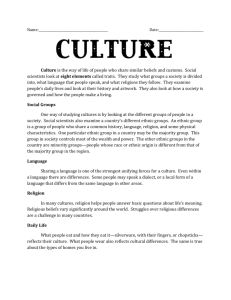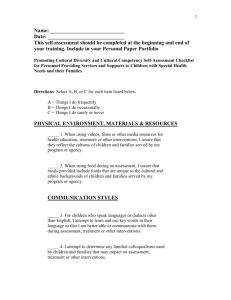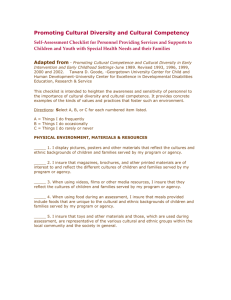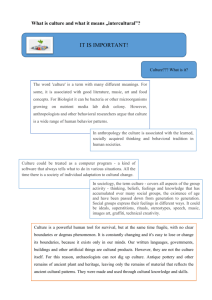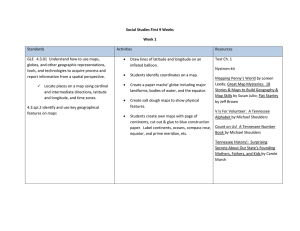Third Grade Social Studies -Second Six Weeks Grade Level
advertisement
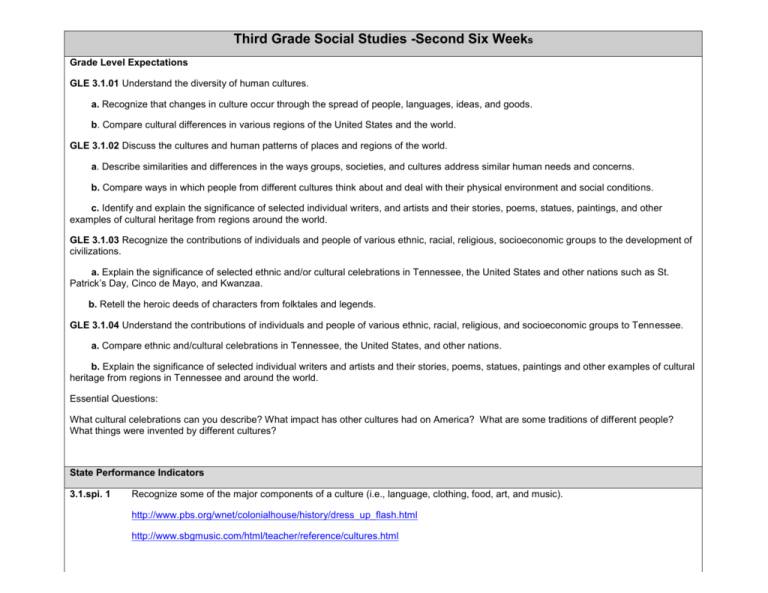
Third Grade Social Studies -Second Six Weeks Grade Level Expectations GLE 3.1.01 Understand the diversity of human cultures. a. Recognize that changes in culture occur through the spread of people, languages, ideas, and goods. b. Compare cultural differences in various regions of the United States and the world. GLE 3.1.02 Discuss the cultures and human patterns of places and regions of the world. a. Describe similarities and differences in the ways groups, societies, and cultures address similar human needs and concerns. b. Compare ways in which people from different cultures think about and deal with their physical environment and social conditions. c. Identify and explain the significance of selected individual writers, and artists and their stories, poems, statues, paintings, and other examples of cultural heritage from regions around the world. GLE 3.1.03 Recognize the contributions of individuals and people of various ethnic, racial, religious, socioeconomic groups to the development of civilizations. a. Explain the significance of selected ethnic and/or cultural celebrations in Tennessee, the United States and other nations such as St. Patrick’s Day, Cinco de Mayo, and Kwanzaa. b. Retell the heroic deeds of characters from folktales and legends. GLE 3.1.04 Understand the contributions of individuals and people of various ethnic, racial, religious, and socioeconomic groups to Tennessee. a. Compare ethnic and/cultural celebrations in Tennessee, the United States, and other nations. b. Explain the significance of selected individual writers and artists and their stories, poems, statues, paintings and other examples of cultural heritage from regions in Tennessee and around the world. Essential Questions: What cultural celebrations can you describe? What impact has other cultures had on America? What are some traditions of different people? What things were invented by different cultures? State Performance Indicators 3.1.spi. 1 Recognize some of the major components of a culture (i.e., language, clothing, food, art, and music). http://www.pbs.org/wnet/colonialhouse/history/dress_up_flash.html http://www.sbgmusic.com/html/teacher/reference/cultures.html 3.1.spi. 2. Determine similarities and differences in the ways different cultural groups address basic human needs (i.e., food, water, clothing, and shelter by interpreting pictures). http://www.itstime.com/jun97.htm http://score.rims.k12.ca.us/activity/konnichiwa/index.html 3.1.spi. 3 Differentiate the cultural population distribution in the United States using a bar graph. http://www.census.gov/newsroom/minority_links/minority_links.html http://www.census.gov/population/www/socdemo/foreign/slideshow/fb2003/fb2003.ppt 3.1.spi. 4 Interpret a chart or map identifying major cultural groups of the world. http://www.census.gov/geo/www/mapGallery/RHOriginPD-1990.html Checks for Understanding or TPI’s Level 1 Exhibit model behavior during a guest speaker’s presentation on cultural aspects. Make and sample foods from regions around the world in order to examine the relationship of the environment and cultural ways people meet their needs. Recognize that the world is made up of many people, and their history may differ from the student’s own by examining artifacts such as a cultural time capsule or a cultural suitcase. Level 2 Study, perform, or listen to music from different cultures. Create an original piece of work that reflects a specific culture reflecting how different cultures use symbols to communicate with each other. Examine cultural folklore and legend from different regions around the world. Investigate the cultural heritage of specific individuals in order to understand the relationships among cultures and ethnic groups. Describe customs, celebrations, and traditions of racial, ethnic, and religious groups in Tennessee and around the world. Create a portfolio individually or with a group on specific cultural groups. Level 3 Compare a different community in the world with their own by examining generalizations, subcultures, similarities and differences by labeling sheets of butcher paper with words or symbols. Give examples of ways people honor traditions in communities around the world. Read aloud various accounts that describe racial and ethnic groups’ contributions to the development of the community and world. Explain how examples of art, music, and literature reflect the time and place during which they were created. Assessment: performance assessment, rubric, teacher-made tests, observations, oral questioning, journaling Academic Vocabulary: agriculture, artifact, ancestor, barter, borders, cardinal directions, distribution, economy, ethnic, exports, geography, global, hemisphere, imports, industry, manufacturing, landforms, latitude, longitude, legend, natural resources, physical map, population, primary source, product, scarcity, rural, suburban, urban, tools, weapons
